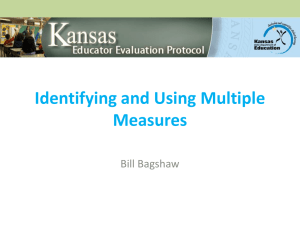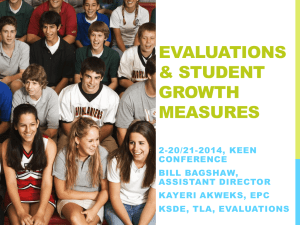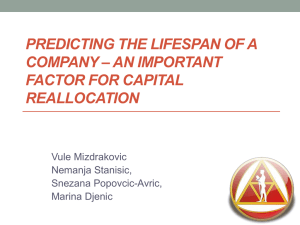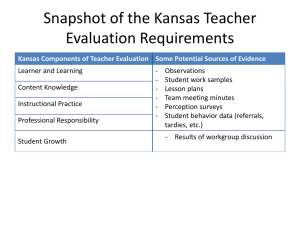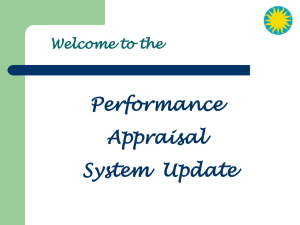What do you know about the 2014-2015 Educator Evaluator System?
advertisement
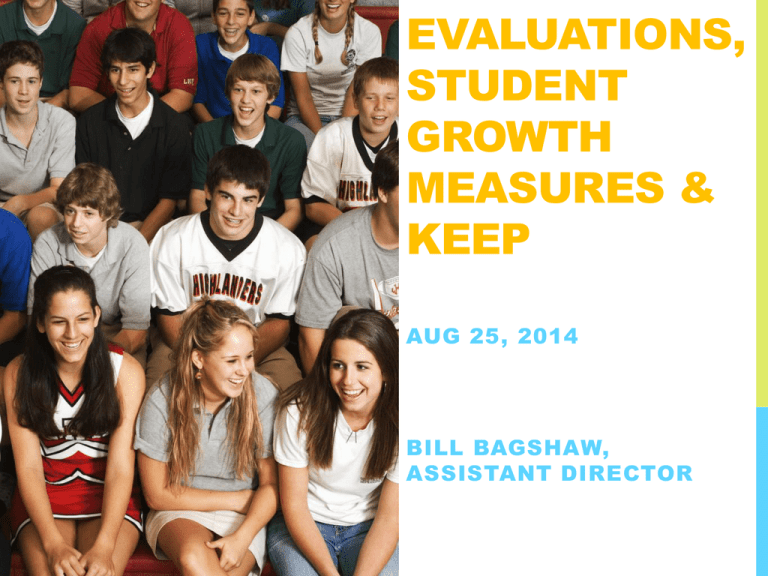
EVALUATIONS, STUDENT GROWTH MEASURES & KEEP AUG 25, 2014 BILL BAGSHAW, ASSISTANT DIRECTOR WHAT DO YOU KNOW? What do you know about the 2014-2015 Educator Evaluator System? WHAT QUESTIONS DO YOU HAVE? What questions do you have about the 2015-2015 Educator Evaluation System? FEDERAL WAIVER – PRINCIPLE 3 SUPPORTING EFFECTIVE INSTRUCTION AND LEADERSHIP Implement teacher and principal evaluation and support systems that: 1. Are used for continual improvement of instruction 2. Use at least 3 performance levels 3. Use multiple measures including student growth as significant factor 4. Are used to evaluate on a regular basis 5. Provide clear, timely, and useful feedback 6. Are used to inform personnel decisions EVALUATION UPDATE AUGUST 2014 • All 286 D2 Assurance online forms have been submitted. • All evaluations systems to be used in Kansas for 2014-2015 have been posted to the Evaluations webpages. • Student Growth Measures Online Forms are on Evaluations website. Principals can use throughout the year to update as needed. PREVIOUS YEARS Chosen Instructional Practice Protocol SUMMARY RATING 2014-2015 Chosen Instructional Practice Protocol IPP SUMMARY RATING FINAL Summative Evaluation Rating Three Student Growth Measures SGMs SUMMARY RATING EDUCATOR EVALUATION SYSTEM Student Learning Content Knowledge Instructional Practice Protocol Summary Rating Instructional Practice Professional Responsibility Student Growth Measure Student Growth Measure Student Growth Measure FINAL SUMMATIVE Rating Student Growth Measures Summary Rating STUDENT GROWTH MEASURES STUDENT GROWTH MEASURES • Kansas requires: • Include student growth as significant factor in evaluation of classroom teachers and building leaders • Multiple measures (>1) required (therefore, 2 or 3 selected for each grade level or content area) • State assessments are required to be 1 of the KEEP SGMs for all grade levels and content areas that give them • Multiple SGMs (>1) must be met by teacher or building leader to allow effective or highly effective rating MULTIPLE STUDENT GROWTH MEASURES 3 2 2 2 1 0 Ineffective Insignificant 3 1 Developing Effective Highly Effective Highly Significant “Multiple Measures” is an educational term used to look at various measures of student growth, in addition to the state assessments. STUDENT GROWTH MEASURES What are any/all student growth measures currently being used in your grade level or subject area? STUDENT GROWTH MEASURES • Select Growth Measures from current measures: • • • SGM documents growth attributable to the teacher or building leader between two or more identified points in time Commercially purchased assessments acceptable as SGM Locally developed assessments acceptable as SGM: • • • Designed, reviewed and used across the district with strict adherence to an inter-rater agreement Created in consultation with school administration with expertise in assessment, special education, ELL specialists and content experts. All grade levels across schools in a single district are advised to use the same measures • Student Growth Objectives (SGOs) or Student Learning Objectives (SLOs) are developed by collaborative districtwide team STUDENT GROWTH MEASURES • Select Growth Measures from current measures: • All grade levels across schools in a single district are advised to use the same measures • Student Growth Objectives (SGOs) or Student Learning Objectives (SLOs) are developed by collaborative districtwide team • Covers all key subject/grade level content standards • Number of test items should correlate to distribution of time spent teaching the content • Require higher order thinking as appropriate • Should allow high and low achieving students to demonstrate knowledge • Valid and reliable STUDENT GROWTH MEASURES • Online form on KSDE Evaluation Website – submit/update SGMs for elementary, middle and high schools • List of possible SGMs on KSDE Evaluation website • Not endorsed or suggested, simply a repository of all being used by districts as submitted to KSDE MET / NOT MET • Decisions on met / not met set scores or minimum levels is made at the District Level. THINKING ABOUT SGMS • SGMs are things students do. • Has the educator being evaluated had a chance to make an impact on the SGM? • • Building Leaders, Counselors, etc.. – make sure the educator being evaluated has been a part of the process in impacting SGMs being used (for example graduation rates, etc.) Secondary teachers – Helpful to use same SGMs for all in same subject area, but only use SGMs that teacher had a chance to impact. For example, teacher of senior level English wouldn’t use State Assessments that were completed before the teacher ever worked with the students. NOTING SGMS IN KEEP WEB APP • SGMs tab in KEEP cannot be filled out until all data is ready to be completed. • Evaluators – note the SGMs in the Beginning of Cycle Conference Discussion Summary. • Gives everyone a “heads up” about what’s coming later in the Formal Evaluation Cycle process. TEACHERS NOT IN FORMAL EVALUATION CYCLE • Gather data. • Set aside artifacts and SGMs results in personal folders and desktops. • Allows teachers to demonstrate quality of teaching beyond Aug – Feb 15th of Formal Evaluation Cycle year! • This process not fully complete/information until 20172018 when multiple years of data has been accumulated. DETERMINING RATINGS THE MATRIX Matrix Activity THE MATRIX RULES • Must meet all three SGMs to be considered highly effective or its equivalent for the SGM Rating. • Must meet at least two student growth measures to be considered effective or its equivalent for SGM Summary rating. • Must meet at least one SGMs to be considered developing or its equivalent for the SGM Summary Rating. • The Final Summative Rating can only be rated one performance level higher than the lowest rating. • When both Summary Ratings are the same, it becomes the Final Summative Performance Rating. REVISIT YOUR QUESTIONS What answers do you have? What questions didn’t get answered? What new questions do you have? CONTACT Bill Bagshaw Assistant Director bbagshaw@ksde.org 785-296-2198 Kelly Dempewolf Program Consultant – Educator Evaluation kdempewolf@ksde.org 785-296-5140
